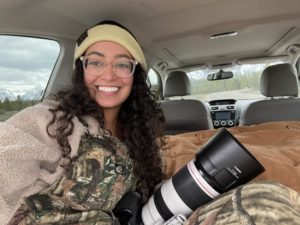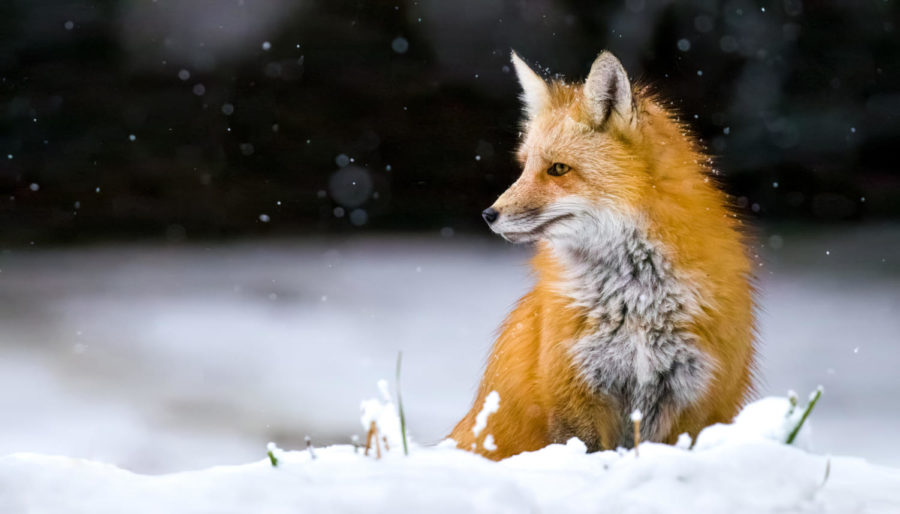Photography in the Wild with Chrissy Shammas
Photography in the Wild with Chrissy Shammas
Chrissy Shammas has been fascinated with wildlife from a young age and has been photographing it for over seven years. When talking with her about her journey as a wildlife photographer, she recalls really getting into photography during her freshman year of college at Virginia Tech. She graduated in 2018 with a BFA in cinema and landed a copywriting job with Pit Viper right out of college that brought her to Utah. She now works as a copywriter for Twisted Tea and focuses on her career and passion as a wildlife photographer as much as possible. During our conversation, Shammas provided intriguing insights and useful tips regarding wildlife photography and her experience in the field.
What made you want to get into wildlife photography?
Shammas expresses how she has always been a big animal lover and can link it back to being a “Pokemon nerd.” She relates photographing wildlife to Pokemon because it’s like “capturing an animal you’ve never caught before,” similar to what you do on the Pokemon Go mobile app. You’re not capturing tangible items, but pixels on a screen. From a young age, Shammas recalls that every time she was in possession of a camera, it was pointed at animals.
What are some tips for finding wildlife to photograph?
When looking for animals to photograph, Shammas shares some helpful tips and tricks. She explains how it’s really a matter of using all of your senses. You keep your eyes trained on the ground in hopes of finding tracks, you strain your ears to hear the communication of the animals around you – you have to constantly be aware and alert of your surroundings. “If you listen for birds, or squirrels, a lot of times when they start really chattering about something, they’re chattering about something for a reason…” A unique part of her process comes in the form of her “scouting missions.” These missions are where she will go to a potential shooting (photography) location and just walk around and scout it out to hopefully find and pinpoint certain areas “so when I come back the next time I know what to look for and the places to check out.”
What is your favorite time of year to photograph wildlife?
Shammas says that while there is something different and unique about every season when it comes to photographing wildlife, winter is probably her favorite season to work in. “I love winter when it snows because they just stand out against the background so well … snow makes them pop.”
What is your favorite wildlife encounter you’ve had so far?
Shammas has a plethora of fascinating and insanely cool wildlife encounters during her many photography shoots out in nature. Hearing about all of them is enough to make anyone want to go in search of wildlife encounters like hers. Shammas tells me that she had her first wolf encounter this year, back in January. “I was in the right place at the right time … I saw her [the wolf] out in the field. She was trotting, and sometimes when you pay attention you can figure out if they’re diagonally making their way somewhere, so I drove up purposefully way far ahead of her. She just came out pretty close to the road. So cool.”
What is your favorite place to shoot?
While Shammas has many places that she likes to go to photograph wildlife, Yellowstone and the Grand Tetons are her favorite places. In her words, they are “the mecca of wildlife photography around here.”
Why is it important to get people outside to observe wildlife?
With the work that Shammas does, she gets a lot of exposure to the natural environment which reminds her of the importance of people getting outside to observe wildlife. “I think when you can see animals up close with your own eyes … you kind of appreciate them better,” Shammas says. She explains that no one forgets when they saw their first bear in Yellowstone, and once they have had that real life encounter with an animal and have formed an emotional memory of it, they are more likely to support preserving their habitat.
What are your next plans?
Shammas has mostly been focusing on the greater Yellowstone ecosystem for the past few years, but she has a bucket list of other places that she would like to spend time photographing in. She is currently applying to be an artist in residence at Great Smoky Mountain National Park for the near future. If she got this opportunity, she would live in the park for four weeks and be supported to take wildlife photography and give a few talks to visitors. She is also going to be a featured artist at the Antelope Island visitor center gallery for two months in December 2022 and January 2023. “I will have the entire space to myself, I think it’s like two 25 square foot walls that I get to fill up … that’s a great honor to me, so I’m excited about that.” She would also like to go up to Canada and Alaska soon to photograph moose and polar bears.

Places to go to photograph wildlife around SLC (list provided by Chrissy Shammas):
- Cottonwood Canyons: Moose, rika, mountain goats, porcupine
- Cemeteries: Deer, owls, foxes, birds
- Swaner Preserve: Elk, potguts, sandhill cranes, birds, beavers
- Antelope Island: Bison, pronghorn, bucks, coyotes, badgers, rabbits, eagles, owls, porcupines
- Bird Refuges (Farmington Bay & Bear River): Bald eagles, raptors, waterfowl, pelicans, weasels


